Are you passionate about the history of D-Day or simply curious? We had the opportunity to visit Sword Beach and its memorials.
Located along the Normandy coast in Calvados, this D-Day beach was part of Operation Overlord launched on June 6, 1944. We took the opportunity to discover several interesting memorials and museums nearby.
In this article, you’ll find a list of 9 best things to do at Sword Beach on the beach and in the surrounding area, based on our experience and our photo tips.
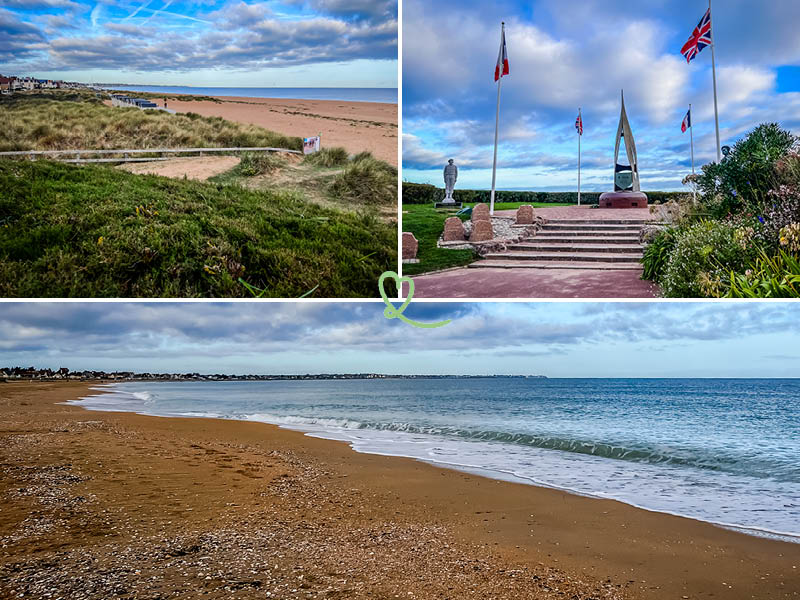
This review is completely independent, we visited anonymously and paid our entrance fees in full.
D-Day at Sword Beach – introduction
D-Day and the role of Sword Beach
Sword Beach is the easternmost beach of D-Day. It was the landing point for British and Allied troops on June 6, 1944, during the Second World War. One of the outstanding units that took part in the landings on Sword Beach was the French Bérets Verts commando led by Commandant Philippe Kieffer. Their participation symbolized France’s commitment to the Allied effort to liberate Europe.
The main aim of Sword Beach was to secure a safe passage point for Allied troops, and to establish a link with nearby beaches. Operations met with less intense resistance than on some other beaches. Allied forces were therefore able to quickly secure the area and advance inland.

What’s on Sword Beach?
Today, you can see the beach and its memorials in honor of the Allied soldiers who died to liberate Europe from the Nazi yoke. Nearby, you’ll find numerous museums and monuments to the Second World War, including the Grand Bunker and Pegasus Bridge. We’ll give you more details later in this article.
You’ll soon have access to a short video listing the must-do activities at Sword Beach.

Practical tips and map: Sword Beach, Normandy, France
Where is Sword Beach?
Sword Beach is a large beach that runs alongside several communes in Normandy, stretching as far as Ouistreham. It is located in the Calvados department in Normandy.
- Driving time from Rouen: 1h50,
- Driving time from Bayeux: 45min,
- Driving time from Caen: 30min
- Driving time from Deauville: 1h05,
- Driving time from Cherbourg: 1h40,
- Driving time from Paris: 3 hours.
Here is a map to help you find your way:
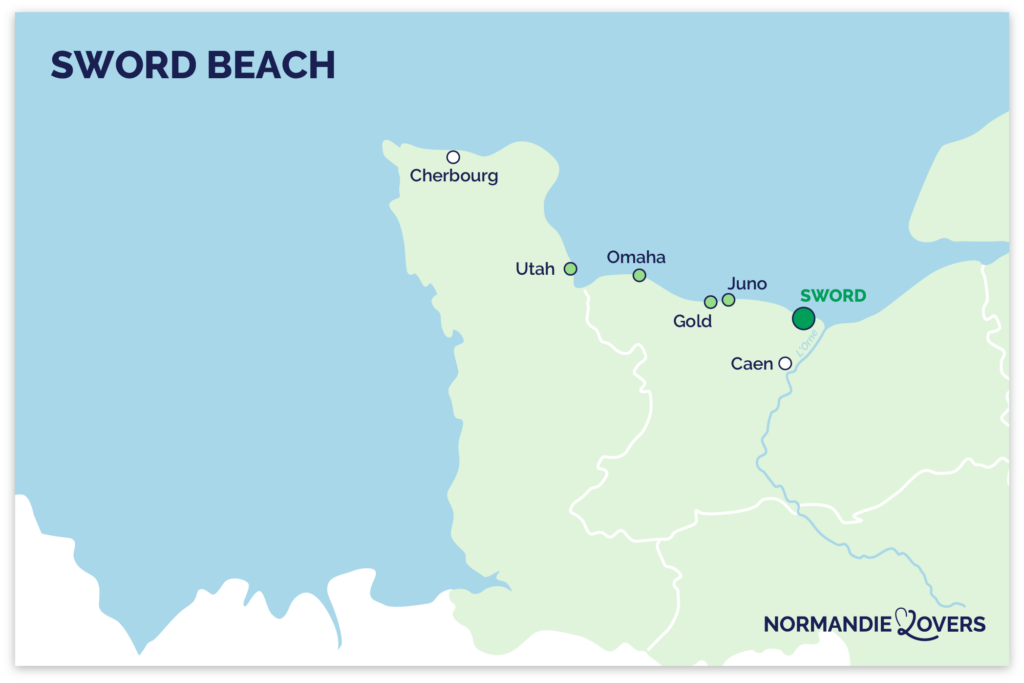
How to get there From Paris, Caen or Bayeux
- By public transport: complicated access, train to Ouistreham then Lion 12EX bus to Bas Lion, then another 15min walk to the beach.
- Excursion from Bayeux – see program and availability.
- Excursion from Caen – see program and availability.
- By car: the easiest way to visit everything, access via the A13 freeway and then the N13 trunk road. From Paris, it’s about a 3-hour drive.
OUR ADVICE FOR RENTING A CAR IN Normandy
- Compare prices on our preferred platform: DiscoverCars – one of the best rated sites.
- Choose a car that is comfortable enough (distances can be long) but compact (some parking lots and villages are narrow).
- Think of thecomplete insurance (some roads are tortuous and narrow).
- There is a lot of demand, book it early.
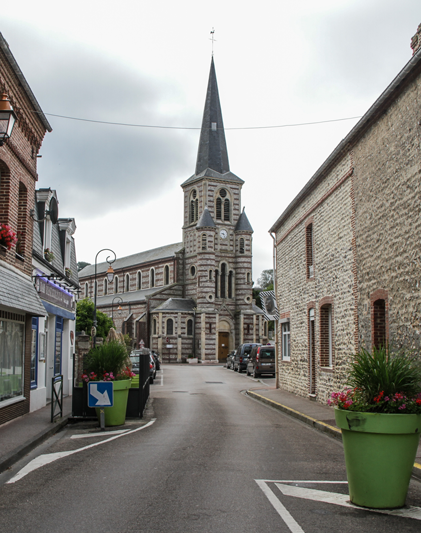
How long will it take to visit Sword Beach?
We recommend that you allow at least half a day to explore Sword Beach, as the experience is really complete if you take the time to visit the Grand Bunker too. Located just 13min from the beach by car, we explored a former Axis command and fire post dating from the Second World War.
Otherwise, we recommend spending 1 or 2 full days there to get a comprehensive overview of all the museums and memorials in the area. And of course, you can decide to stay longer if you want to discover other D-Day sites in Normandy.

What to do in Sword Beach if you only have half a day or a day?
If your timing is tight, we recommend you prioritize the following activities:
- walk along the beach and observe its various memorials, including the La Flamme memorial,
- visit the Atlantic Wall Museum,
- see Pegasus Bridge and its memorial museum,
- climb up to the belvedere (square Alfred Thomas) for a pleasant view.
Of course, if you have more time, we recommend exploring the other sites listed in this article to complete your D-Day experience.

1. Along the beach and its memorials
Why walk along the beach and discover its memorials?
Less impressive than Omaha Beach or Utah Beach, this beach nonetheless features several interesting memorials. If you take the time to walk along the stretch of sand, you’ll discover memorials facing the sea along the way. We were particularly struck by La Flamme, which honors the memory of the Commando Kieffer. It was the only French battalion to take part in the D-Day landings. These 177 soldiers were also known as the Green Berets.

We also recommend that you take the time to observe the beach and the horizon. Can you visualize the scene? You have to imagine boats loaded with young fighters arriving in the distance, and planes dropping their paratroopers from the sky. A way of imagining what the young Allied soldiers must have felt.

What you will see
Stroll along Sword Beach and you’ll discover a number of monuments and memorials to Allied soldiers:
- the monument to the Free French, also known as La Flamme,
- the merchant navy men’s memorial,
- the memorial to bagpiper Bill Millin.

Practical advice
The beach is accessible free of charge all year round. We advise you to check the weather conditions before coming, as this is an entirely outdoor visit.
STAYING NEAR THE D-Day beaches
Option 1: Bayeux
The most practical option, in our opinion, is to base ourselves in the town of Bayeux. We recommend..:
- Hotel Domaine de Bayeux in an 18th century mansion – see prices, photos and availability
- see all top rated accommodations in Bayeux

Option 2: in the countryside
In the countryside around the D-Day beaches, you will find beautiful buildings with a lot of charm: farms, manors…
- Hotel Domaine d’Utah Beach – prices, pictures and availability
- Hotel Ferme de la Rançonnière – prices, pictures and availability

Option 3: next to one of the beaches
If you’re looking for a seaside holiday or are fascinated by one of the beaches, you can choose a more specific hotel:
- Hotel Villas d’Arromanches in Gold Beach Beach – prices, pictures and availability
- Hotel La Sapinière in Omaha Beach Beach – prices, pictures and availability

2. Visit the Grand Bunker (Ouistreham)
Why visit the Museum of the Atlantic Wall (Sword Beach)?
This museum is one of the few authentic blockhouses preserved in France. The centerpiece of the Atlantic Wall (or Atlantikwall in German), the Great Bunker is one of the many fortifications built under the authority of Adolf Hitler to prevent an Allied invasion during the Second World War.
Fascinated by the history of the D-Day landings, the museum’s founders and owners, Fabrice and Brigitte Corbin, have done a remarkable job of retracing the history of the Atlantic Wall and the daily lives of German soldiers up to D-Day on June 6, 1944. In our opinion, this museum is a must-see if you’re visiting Ouistreham. It’s an ideal starting point for discovering the D-Day landing beaches.

What you will see
This museum houses a vast collection on the Atlantic Wall, so you’ll be able to take a closer look:
- the “Saving Private Ryan” barge,
- tanks, cannons and artillery arsenal,
- scenes of soldiers in action in the bunker,
- everyday objects,
- medical equipment,
- means of communication,
- a rangefinder offering a view of the bay,
- the terrace at the top of the Grand Bunker.

Practical advice
Schedules:
- open from 10am to 6pm from February 5 to March 31, from October 1 to November 13 and from December 17 to January 2,
- open from 10am to 6pm weekends from November 14 to December 16,
- open from 9am to 7pm from April 1st to September 30th.
Price:
- full price for adults and children over 13: 8€,
- reduced rate for children aged 6 to 12: €6,
- free for children under 6.
Official website here.
Read our article on the Grand Bunker in Ouistreham.
3. Discover Pegasus Bridge (Bridge and Memorial)
Why visit the Pegasus Bridge Museum (Memorial)?
The Pegasus Bridge (named after the military operation) is one of the great treasures of Normandy’s historical heritage. On display in the park of the Pegasus Memorial, we were able to contemplate it before moving on to the Bénouville bridge, which houses its reproduction. If you are in the area, this is a place not to be missed! The bridge even features in the 1962 World War II masterpiece “The Longest Day”.
We also took the opportunity to visit the museum. It traces the arrival of the first soldiers of the British 6th Airborne Division, also known as the Red Berets, prior to D-Day. In our opinion, this memorial offers a detailed perspective on Operation Tonga, and the crucial role played by paratroopers in the success of D-Day.

What you will see
Inside the memorial, you can see military equipment, and outside, war machines:
- the Pegasus Bridge,
- Bailey Bridge,
- the Horsa glider in which you can ride,
- war vehicles,
- vintage communications equipment,
- everyday objects such as cigarette packets,
- berets and soldier badges, etc.

Practical advice
Schedules:
- open from 10am to 5pm from February to March and from October to December 15,
- open from 9:30 am to 6:30 pm from April to September,
- closed from December 16 to January 31.
Price:
- full adult price: €8.90,
- children (over 8): €5.50.
Official website here.
See organized tours of Pegasus Bridges and other D-Day sites.
4. Climb to the belvedere (Alfred Thomas square)
Why climb to the belvedere (Ouistreham)?
Perched at the top of Square Alfred Thomas in Ouistreham, the belvedere offers a unique panoramic view of Sword Beach and the bay of Normandy. This structure, built by the Germans during the Second World War, contained an anti-aircraft gun. During the Occupation, a British fighter plane was shot down by this artillery. On June 6, 1944, a Nazi sniper killed Paul Rollin, a French soldier and member of the Commando Kieffer, in mid-air. We had trouble imagining the scene, so peaceful is the place these days.
From this promontory, take a few minutes to view the Allied soldiers landing on the beach below. Then look up at the skies filled with warplanes, and put yourself in the shoes of the combatants. How were they supposed to feel?

What you will see
Once you’ve reached the top of the lookout, you can contemplate the view over the sea and Sword Beach. You’ll even find a circular orientation table showing the 4 cardinal points and the monuments to see in the area.

Practical advice
The square is accessible free of charge at all times. There are no fences to delimit it.
We recommend checking weather conditions before climbing up to the lookout. The view is more pleasant on a sunny day.
MORE ABOUT THE D-Day sites
- The best landing sites to visit
- Visit the 5 D-Day landing beaches
- Where to stay – best hotels near the beach
- The best D-Day museums in Normandy
- German batteries to visit
- Car rental tips: Caen – Roissy-CDG – Orly – Beauvais
- Visit Omaha Beach
- Visit Utah Beach
- Visit Gold Beach
- Visit Sword Beach
- Visit Juno Beach (coming soon)
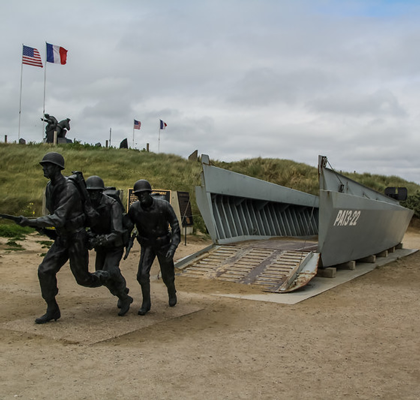
5. Explore the Commando Museum n°4
Why visit the No. 4 Commando Museum (Sword Beach)?
Located on the first floor of a building, this small museum dedicated to Commando No. 4 features authentic accounts of the D-Day landings at Sword Beach. Created by veterans of the Kieffer Commando, it offers an inside look at the events, with a film, re-enactments and military artefacts. Sadly, we have learned of the recent death of Léon Gautier, one of the 177 Green Berets who fought on D-Day in Normandy. He regularly shared his experiences with museum visitors. We found this visit touching, because it had a more human dimension.

What you will see
In this small museum dedicated to the Kieffer Commando, you can observe..:
- a video retrospective of June 6, 1944,
- archive photos,
- military equipment,
- models,
- uniforms, including the famous green beret.

Practical advice
Schedules:
- open from 10am to 1pm and 2pm to 6:30pm every day from April 8 to November 12,
- closed the rest of the year.
Rates:
- full adult price: €5,
- children (over 10): €3.
Official website here.
6. Discover the Hillman site (Colleville-Montgomery)
Why explore the Hillman fortification?
Built by Hitler’s army between 1942 and 1944, the Hillman fortification was a major military defense installation during the Second World War in Normandy. The 24-hectare site comprises 18 structures, including a museum housed in a bunker. We were able to walk through the trenches, and explore the estate’s many buildings.
Members of the association Les Amis du Suffolk Regiment have been reconstructing the German site over several years since 1989. On D-Day, this strategic blockhouse was targeted by the Allies. The following day, June 7, 1944, it was liberated thanks to the intervention of the Suffolk Regiment. You’ll have guessed where the association gets its name from.

What you will see
Take a look at the Hillmann site:
- blockhouses,
- a museum in a bunker,
- a Churchill tank,
- a water tank and a well,
- kitchens,
- guard posts,
- a command post,
- a network of trenches.

Practical advice
Visit the fortifications and museum free of charge from July to September every day (except Sunday) from 10am to 12pm and from 2:30pm to 6:30pm. During the same period, volunteers from Les Amis du Suffolk Regiment offer guided tours on Tuesdays only.
See tours that stop at the Hillman site.
Subscribe to our Newsletter
- Get away from it all with Region Lovers’ beautiful destinations!
- Once a month
- Advertising-free
7. Hermanville-sur-Mer British Cemetery
Why visit the British Cemetery (Hermanville-sur-Mer)?
Although not on the scale of the American Cemetery, the British Cemetery is also an important place of remembrance. It houses the gravestones of 1,005 Allied soldiers, including 986 British, as well as a small chapel. Located in the immediate vicinity of Sword Beach, Hermanville-sur-Mer also experienced the D-Day landings and suffered their consequences. We went under the arch of the church. We found the place to be peaceful and serene.

What you will see
In the British Cemetery at Hermanville-sur-Mer, you can see rows of graves, the vast majority of which are of British soldiers. A small chapel overlooking the cemetery gives the place a great deal of solemnity.

Practical advice
We recommend that you check weather conditions before visiting this cemetery. The visit will take place almost entirely outdoors. Access to the site is free of charge.
Coming soon, our article dedicated to Hermanville-sur-Mer British Cemetery near Sword Beach.
8. Visit Ranville British Military Cemetery
Why visit Ranville Military Cemetery?
Just 2km from Pegasus Bridge in Ranville is the largest British military cemetery in Calvados (after Bayeux). The work of English architect Philip Hepworth, this is a calm and restful place. It houses 2,564 soldiers’ graves, most of them British. Indeed, Ranville was the first village in France to be liberated by the British Army’s 6th Airborne Division. We visited the 2 English cemeteries at Hermanville-sur-Mer and Ranville. The comparison is interesting, as we have noted some similarities.

What you will see
In Ranville Cemetery, you can see:
- rows of carefully tended graves,
- the cross of sacrifice,
- the 6th Airborne Division Memorial,
- the grave of dog handler Émile Cortell, who parachuted in with his dog Glenn,
- the Stone of Remembrance and Shelter,
- the Commonwealth War Graves (CWGC) in Ranville Chruchyard.

Practical advice
We recommend that you check weather conditions before visiting this cemetery. The visit will take place almost entirely outdoors. Access to the site is free of charge.
Official website here.
Coming soon, our article dedicated to Ranville British Cemetery near Sword Beach.
USE OUR GUIDE TO PLAN A
DREAM TRIP TO Normandy
All the information you need for your trip:
- 8 maps that make planning easier
- 160+ pre-selected locations
- Practical advice
- 300+ photos to help you choose
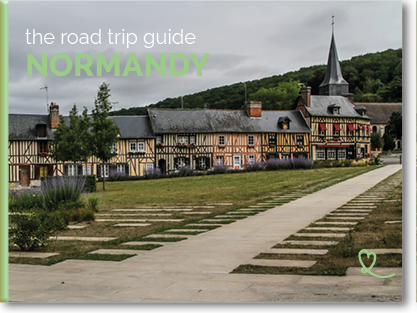
9. Visit the Franco-German Radar Museum (Station Radar 44)
Why visit Station Radar 44 (Sword Beach)?
This site played a major role in the Second World War. Learn more about radar equipment and its performance, and what life was like for German soldiers in the bunkers. We found this immersion in radar warfare very rewarding.
Radar Station 44, like the other radar stations on the Atlantic Wall, played an important role in monitoring and defending the coastline against Allied air and naval attacks. These installations had a significant impact on military operations, and contributed to the weakening of German defenses on the Normandy coast. The visit was very interesting, as it looked at war from a communications angle.

What you will see
If you’ve decided to visit the Musée du Radar in Douvres-la-Délivrande, you’ll be able to take a closer look:
- Würzburg-Riese radar,
- the cotal (the first French radar installed on a removable trailer),
- SCR 584 radar,
- Freya radar,
- life-size reconstructions,
- military communications equipment,
- voice testimonials,
- models,
- bunkers (command post, factory shelter, accommodation shelter, etc.)

Practical advice
Schedules:
- open daily from 10am to 7pm in July and August,
- open daily from 10am to 6pm (except Mondays) from April to June and from September to mid-November (approx.),
- closed from December to March.
Price:
- full adult price: €6.50,
- children (under 16): €5.
Official website here.
Coming soon, our article dedicated to Radar Station 44.
PLAN YOUR TRIP TO Normandy
Inspiration destinations
- Deciding where to go in Normandy – the best destinations
- Our weekend ideas: best-of, romantic, unusual, seaside, luxury, family
- 16 seaside hotels in Normandy
- The most beautiful charming hotels in Normandy

Best of

Practice
- Where to stay in Normandy – best places and hotels
- See our tips for renting a car at CDG airport, Orly airport, Beauvais airport, Caen, Rouen, Bayeux…

What to do around Sword Beach: other ideas
Caen Memorial
Inaugurated in 1988 by François Mittérand, the memorial aims to promote peace and pay tribute to the victims of the Second World War. Thanks to interactive exhibits, historical documents and moving personal accounts, you’ll gain a deeper understanding of this tragic period in world history. We’ll never forget our visit to the museum, because we were captivated and educated! If you’d like to visit, get your ticket now!

Read our article on the Caen Memorial.
Juno Beach Center
Canada’s only D-Day museum, it offers a rich interactive experience covering army mobilization, the civilian effort, life in Canada, and participation in all the battles. Its architecture is highly recognizable, with its pentagonal structure reminiscent of a maple leaf. It pays tribute to the 45,000 Canadians who lost their lives in the Second World War, and to the 381 who fell on D-Day. In our opinion, it’s an excellent D-Day museum. You can also visit it on an organized tour that includes the center and other D-Day sites.

Read our article on the Juno Beach Centre.
Merville Battery Museum
We love visiting military batteries. In Merville-Franceville-Plage, you’ll find combined batteries and a museum. The bunkers withstood numerous bombardment assaults, and were captured with difficulty by the British 9th Parachute Battalion. You’ll find bunker scenes, a Douglas C-47 aircraft and other equipment. More information on the official website here.

Coming soon, our article dedicated to the Merville Battery Museum near Sword Beach.
OUR ADVICE FOR RENTING A CAR IN Normandy
- Compare prices on our preferred platform: DiscoverCars – one of the best rated sites.
- Choose a car that is comfortable enough (distances can be long) but compact (some parking lots and villages are narrow).
- Think of thecomplete insurance (some roads are tortuous and narrow).
- There is a lot of demand, book it early.

Bény-sur-Mer Canadian Cemetery
This cemetery contains the graves of Canadian soldiers who fell during the Second World War, mainly during the Battle of Normandy and the operations that followed D-Day. This place of rest and remembrance has left its mark on us. We were able to appreciate the commitment of these young foreign fighters, ready to sacrifice their lives for freedom.

Coming soon, our article dedicated to the Bény-sur-Mer Canadian Cemetery near Sword Beach.
Ver-sur-Mer British Memorial
This memorial is specifically located near Gold Beach. It honors the contribution of the British and Commonwealth forces who landed at this crucial location, and played a major role in Operation Overlord. We discovered information panels, sculptures and commemorative steles recalling the events of the D-Day landings.

Coming soon, our article dedicated to the British Memorial at Ver-sur-Mer near Sword Beach.
Subscribe to our Newsletter
- Get away from it all with Region Lovers’ beautiful destinations!
- Once a month
- Advertising-free
Visit the other D-Day beaches: Omaha, Utah, Gold, Juno
After seeing Sword Beach, would you like to discover the other D-Day beaches? You can consult our article on the 5 D-Day beaches, and our article on the best sites, to decide on your next destination. They’re all must-sees on a trip to Normandy. Their story is both heartbreaking and inspiring.
- What to do in Omaha Beach,
- What to do in Utah Beach (coming soon),
- What to do in Gold Beach (coming soon),
- What to do in Juno Beach (coming soon).

Frequently asked questions
Why Sword Beach?
Sword Beach is the code name given to one of the 5 Normandy landing beaches during Operation Overlord in the Second World War. Each D-Day beach had a code name, which was used for planning and communication between the Allied forces.
Sword Beach comes from sword fish and Gold Beach from goldfish.
Which route to take to visit the D-Day landing beaches?
Don’t want to go to the trouble of organizing your visit to the D-Day landing beaches? And you don’t know where to start? We strongly recommend that you opt for an organized tour. Accompanied by a guide, enjoy a complete, time-saving tour.
See organized tours of Sword Beach and other D-Day sites.
All our tips in this article were put into words with the help of Elisa.



